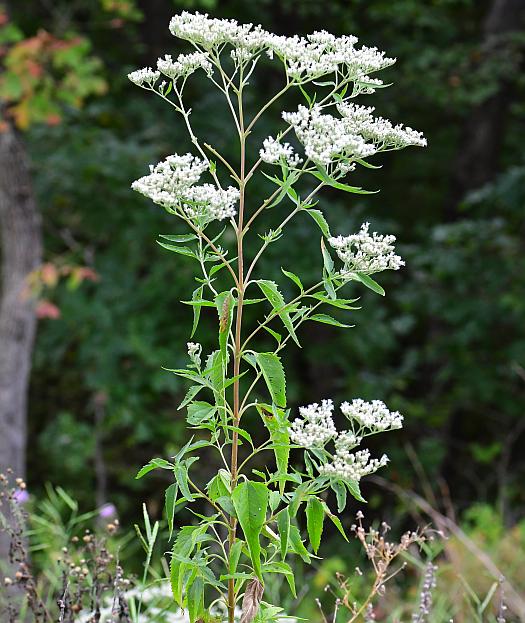Eupatorium serotinum Michx.
Late Boneset

Native
CC = 1
CW = 0
MOC = 76
© SRTurner
Eupatorium serotinum Michx.Late Boneset | |
 |
Native CC = 1 CW = 0 MOC = 76 |
© SRTurner |
|
Family - Asteraceae/Eupatorieae Habit - Perennial forb with fibrous roots. Stems - Erect, to 2 m, not hollow, densely short-hairy above the sometimes nearly glabrous basal portion, tan to grayish purple, not glaucous, often producing small fascicles of axillary leaves much shorter than the main stem leaves, at least at a few nodes.
Leaves - Opposite, sometimes alternate at upper nodes, simple, petiolate. Petioles distinct, 8-30 mm long. Leaf blades 3-20 cm long, 6-100 mm wide, narrowly lanceolate to ovate, angled or tapered at the base, tapered to a sharply pointed tip, the margins sharply and often coarsely toothed, the upper surface glabrous to moderately short-hairy, the undersurface moderately to densely short-hairy, both surfaces also sparsely to moderately gland-dotted, with 3 main veins, the lateral veins branching from at or just above the base of the midvein.
Inflorescence - Terminal panicles with numerous flowering heads, flat-topped or shallowly domed.
Heads - Discoid. Involucre 3-4 mm long, cup-shaped, the bracts oblong-lanceolate to narrowly oblong, rounded to bluntly or less commonly sharply pointed at the tip, the margins thin and pale or transparent, especially toward the tip, mostly faintly 3-nerved, densely short-hairy, green but appearing mostly gray.
Flowers - Ray florets absent. Disc florets 9-15. Corollas 2.5-3.5 mm long, 5-lobed, the surface often somewhat glandular, white. Pappus of capillary bristles.
Fruits - Achenes 1-2 mm long, black at maturity.
Flowering - August - October. Habitat - Upland prairies, glade margins, savannas, forest openings, streambanks, pond margins, bluffs, fields, pastures, gardens, railroads, roadsides, disturbed areas. Origin - Native to the U.S. Lookalikes - E. altissimum. Other info. - This species is the commonest and weediest of Missouri's thoroughworts. It has little habitat preference, growing in nearly any reasonably open area. It is often a dominant presence in fields in late summer, along with tall goldenrod and other disturbance-adapted species. It is found across Missouri, though curiously uncommon in parts of the Ozarks, and across most of the eastern U.S. It is recognized by its mostly opposite, toothed leaves having distinct petioles, and large panicles of small flowering heads. The heads contain 9-15 individual florets. From a distance, the inflorescences often have a slight grayish cast (sometimes referred to as "dirty dishwater"), possibly due to the black anther tubes which are too small for the eye to resolve at a distance but which contribute the grayish tint. Photographs taken off Hwy 60, Carter County, MO., 8-28-03 (DETenaglia); also at Greensfelder Park, near Pacific, St. Louis County, MO, 9-22-2012, and at Don Robinson State Park, Jefferson County, MO, 9-10-2021 (SRTurner). |